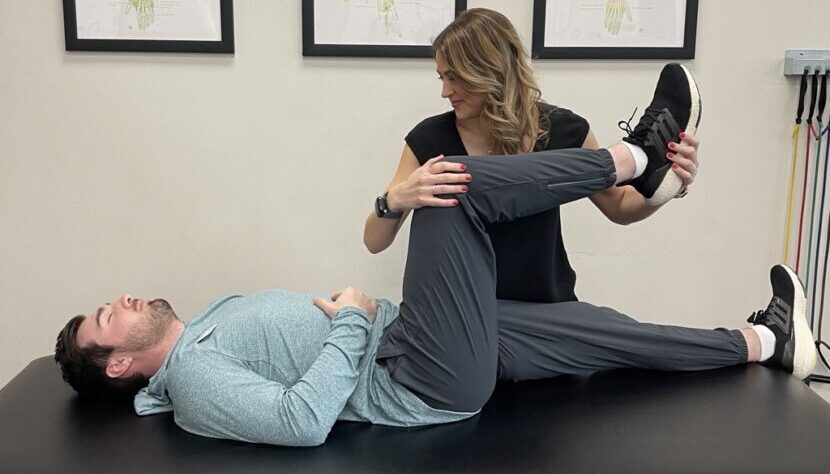Any way you look at the numbers, total joint replacements are huge business. An estimated 50 million U.S. adults are currently diagnosed with osteoarthritis (OA). It’s the leading cause of disability in U.S. adults, and costs employers an average of over $9,000 per year per employee.
There are more than one million hip and knee replacements performed each year in the United States. And these numbers are only the beginning — total hip replacements (THRs) are projected to grow by 174% (572,000 patients) between 2005 and 2030, and total knee replacements (TKRs) by 673% (3.48 million patients).
The biggest change in the rehabilitation of patients who undergo total knee and hip replacement is the trend toward earlier and more intensive rehabilitation, said Kristen Burke, MSPT, orthopedics advanced clinician II at Thomas Jefferson University Hospital in Philadelphia. Patients are typically up and moving the same day, bearing full weight with therapist assistance.
In 1991, patients remained in the hospital an average of 9 days after hip replacement surgery, as reported in an April 2011 study in JAMA. Now, most patients are home the next day. However, the cost of post-acute care, primarily in skilled nursing facilities and home health agencies, has skyrocketed.
The Role of ‘Pre-hab’
While much of the attention and published research data has connected optimal outcomes to sustained and physical therapist-directed rehabilitation, new insight is quantifying the role of pre-habilitation as well.
A study released in Oct. 2014 found that physical therapy before joint replacement surgery can diminish the need for postoperative care by nearly 30 percent. This reduction can save an average of $1,215 per patient in skilled nursing, home health or other postoperative care environment.
The study, which appeared in the Journal of Bone & Joint Surgery, used Medicare claims data to identify pre-op and post-op care usage patterns for 4,733 THR and TKR patients. Post-op care was defined as the use of a skilled nursing facility, home health agency or inpatient rehabilitation center within 90 days of hospital discharge.
Results showed that approximately 77% of patients utilized care services following surgery. After adjusting for demographic characteristics and comorbidities, patients receiving pre-op PT showed a 29% reduction in post-op care.
In addition, 54% of the pre-operative PT group required postoperative care services, compared to 80% of patients who did not receive pre-op therapy. Pre-op care cost an average of $100 per patient, and was generally limited to one or two sessions.
“This study demonstrated an important opportunity to pre-empt postoperative outcome variances by implementing preoperative physical therapy along with management of comorbidities before and during surgery,” said study co-author Ray Wasielewski, MD, an orthopedic surgeon at Minimally Invasive Orthopedics in Columbus, Ohio.
Appropriateness Criteria
With such a profound expansion in patients undergoing total joint replacement procedures, researchers are examining whether these surgeries fit established appropriateness criteria. A new study published in Arthritis & Rheumatology finds that up to one-third of these procedures could be classified as “inappropriate.”
“To my knowledge, ours is the first U.S. study to compare validated appropriateness criteria with actual cases of knee replacement surgery,” said lead author Daniel Riddle, PT, PhD, FAPTA, Otto D. Payton Professor of Physical Therapy at Virginia Commonwealth University in Richmond.
“Our finding that one-third of knee replacements were inappropriate was higher than expected and linked to variation in knee pain [osteoarthritis] severity and functional loss,” Riddle said. These data highlight the need to develop patient selection criteria in the U.S.”
Riddle examined a modified version of an appropriateness classification system developed in Spain, as well as the Western Ontario and McMaster Universities Arthritis Index (WOMAC) Pain and Physical Function scale.
The Spanish criteria are considered by many experts to be “among the most powerful tools for improving quality of care and controlling costs,” according to Riddle. His analysis finds that 44% of TKA surgeries were “appropriate,” 34% were “inappropriate,” and 22% were “inconclusive.”
The classification systems were used to assess participants enrolled in the Osteoarthritis Initiative, a 5-year study of 4,796 people partly funded by the National Institutes of Health. Riddle’s study looked at a subset of 175 patients. Mean patient age was 67 years old, and 60% of subjects were female.
In a related editorial, Jeffery Katz, MD, associate physician at Brigham and Women’s Hospital in Boston, corroborated the conclusions of Riddle’s research. “We should be concerned about offering total knee replacements to subjects who endorse ‘none’ or ‘mild’ on all items of the WOMAC pain and function scales,” said Katz.
The study also highlights that there are many variables involved in the decision to undergo TKA surgery, including severity of symptoms and the psychological readiness of the patient.
The study, “Using a validated algorithm to judge the appropriateness of total knee arthroplasty in the United States: a multi-center longitudinal cohort study,” was published in the June 2014 issue of Arthritis & Rheumatology.
Large-scale Data Collection
Such a sizable group of patients necessitates ambitious data-gathering projects to assess the current state of joint replacement outcomes.
A consortium of 150 orthopedic surgeons across 22 states have banded together to contribute to FORCE-TJR, a vast database that draws on more than 30,000 patients and joint replacement surgeries, and growing. FORCE-TJR is a total joint replacement registry that captures and provides comprehensive TJR data to surgeons and hospitals in an effort to improve patient care, develop best practices and advance quality of life for people with arthritis.
Originally established under a $12 million grant from the Agency for Healthcare Research & Quality, FORCE is a surgeon-led effort that documents patient-reported outcomes, including pain relief and functional gain readmissions, adverse events and implant survival. David Ayers, MD, and Patricia Franklin, MD, of UMass Memorial Medical Center in Boston, are the co-leads of FORCE-TJR.
One major finding of the data involved the rapid growth of the operations, said Ayers. “[Joint replacement] is now the most common operation performed in the U.S., and the greatest expense of the Medicare budget,” he said. And the numbers are trending markedly younger. “Patients less than 60 years are the most rapidly growing demographic,” Ayers explained.
But while the widely held belief is that these younger patients represent a fit, otherwise healthy population seeking to retain their active lifestyles, the data reveal quite the opposite. “We found some surprising factors,” said Ayers. “Patients under 60 undergoing joint replacement have a higher BMI and are more obese than older patients. They have just as many comorbid medical conditions as their older peers. At some point they were active, but now they’re every bit as disabled and in pain.”
Another lesson revealed by the data is the importance of living environment for patients post-surgery. After adjusting for medical and social risk factors associated with poorer outcomes, the data shows that six months after hip replacement surgery, patients living alone report more pain in their surgical joint than patients living with at least one other adult. So while further research is needed to determine the specific reasons, the study indicates that following a joint replacement surgery, it may be beneficial for patients to have regular support of friends and family for optimal recovery.
Strong Record of Success
The data compiled by the FORCE-TJR initiative is paying dividends in the form of dozens of published research trials and treatment recommendations. One of the more critical findings, according to Ayers, involves the timing of when a patient and his healthcare team decide that joint replacement surgery is warranted.
“When should patients undergo this procedure? That’s a difficult decision for a patient,” Ayers said. “Many times, the advice has been, ‘put up with it as much as you can. When you can’t deal with it any longer, we’ll discuss surgery.'” In examining the data, Ayers and colleagues found wide consensus surrounding the point that joint replacement should be considered — when the physical component score (PCS) of the SF-36 patient self-assessment was 32. If patients wait until their scores on this assessment are lower, their post-op outcomes will be lower as well. “It’s possible to wait too long for this procedure,” said Ayers, who plans to crunch the FORCE-TJR data to bring insight into the role of rehabilitation programs to elevate patient outcomes.
But above all, he’s encouraged by the stories of success he sees in patients receiving these procedures.
“Of all the operations [we] perform in medicine, when you compare any intervention based on improvements in quality of life years, hip and knee replacements are #1 and #2 on the list, respectively,” said Ayers. “When you consider improvements in health, mobility, pain levels, and function, not to mention the financial benefits of remaining independent, these are among the most beneficial treatments in modern medicine.”
This article was originally posted on Physical-Therapy.Advanceweb.com. Click here to view it.



